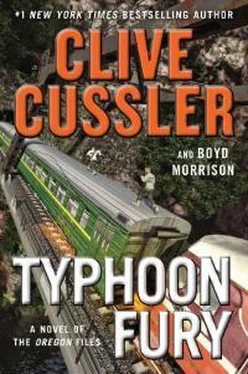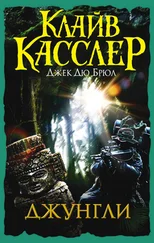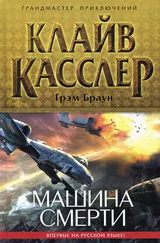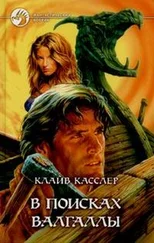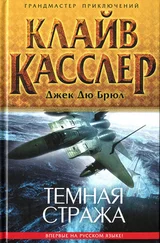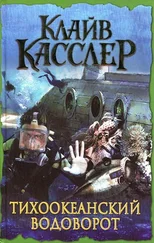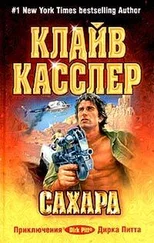“Wrap him up in the sheet,” Brekker said.
“Same treatment we gave Polten and his friend?”
Brekker nodded. They’d disposed of the two American chemists’ bodies by weighting them down and dumping them overboard during the trip from Manila.
He went up on deck. And, several minutes later, the men brought up the body with the bloody sheet around it. It was fastened with a nylon rope, and a kettlebell weight was lashed to Lynch’s feet.
“With that much blood to attract the sharks,” Brekker said, “they’ll make short work of him.”
He looked around to see if there were any witnesses but shouldn’t have bothered. The only visible ship was a ferry on the horizon.
“Do it,” Brekker said, and the men tossed the body into the water. It immediately sank from view.
“Get the dive gear ready,” he told the men. Although it was late afternoon, they’d still have a few hours of daylight to do an initial reconnaissance.
Brekker went to the cockpit and put them back on course. NUMA had helpfully provided the longitude and latitude of the wreckage to Polten, and the GPS system was guiding him to that precise spot only five hundred yards from the islet.
Though fishermen had discovered the Pearsall weeks ago, the wreck was located far from the normal tourist dive spots, and recreational companies had been warned to stay away until NUMA had completed its survey to assess the danger from unexploded ordnance on board.
It looked like the warning had worked because when the yacht arrived, they had the place all to themselves. At the indicated location, Brekker motored back and forth over the coordinates, a sandy stretch of seafloor fifty feet deep. He kept an eye on the bottom-scanning sonar until he saw the angular shape of a ship’s bow jutting from the sand.
After dropping anchor and shutting off the engine, he went back to the aft deck to find his four mercenaries already donning their wetsuits.
“How could the Pearsall have been undiscovered here for more than seventy years?” one of them asked as he checked his oxygen tank. “It’s deserted right now, but we’re not exactly in the middle of nowhere.”
Brekker shrugged into his own suit. “It was probably covered by sand in a typhoon like the one that’s approaching and then uncovered by normal erosion, which is why we need to get down there now. Hidalgo might cover it up again.”
When they were ready, the five of them went over the side.
Brekker immediately spotted the prow of the destroyer in the crystal clear water. He could make out the top of the ship’s hull number stenciled on the side: DD-542. The warship must have come to rest on the bottom with its stern lower than the bow. The top of the superstructure barely peeked above the surface of the sand. Most of the metal showed very little corrosion, supporting the theory that the entire ship had been buried in the sand until recently.
If they were going to explore the interior of the Pearsall , they’d have to find a way inside, but all of the visible port hull was intact. Brekker had acquired underwater cutting torches, but he hoped to find an easier way in.
He led his men around the ship and saw just what he was looking for: a jagged hole where the Japanese torpedo had hit. Most of the hole was filled with sand, but Brekker thought they could dig their way through.
And if they couldn’t, carefully placed explosives would make sure no one else would be able to, either.
44
CORREGIDOR
At the sound of a vehicle in the distance, Juan held up his hand to stop his team. Eddie, Linc, MacD, Raven, and Max all froze in their tracks. When it was clear that the vehicle was approaching, Juan motioned for them to take cover. They all dropped to the ground, shielded from the road by the island’s thick woods.
Getting from the Gator onto Corregidor had gone as expected. No one had been at the unused airfield to see them come ashore. They’d been making their way through the underbrush to avoid being spotted along the road. All of them were equipped with M4 assault rifles, except for MacD, who had his crossbow. They wore green and sand colored camouflaged fatigues and helmets similar to those worn by the Philippine National Police Special Action Force. On their chests and backs were Velcro panels that would reveal the words PNP-SAF and POLICE when torn away. Around their necks were balaclavas that could be pulled up over their faces to conceal their identities, just like the police would wear on a drug raid.
Juan didn’t know if Locsin was inside the tunnel, but the plan was to capture Locsin’s men alive and then march them the quarter mile to the south dock, where the Oregon ’s more spacious lifeboat would pick them up. By the time the actual Philippine police made it out to the island, they’d be long gone and would be able to conduct the interrogation in private to find out Beth’s location.
The tranvía tram passed by without slowing, likely heading to the Japanese Garden of Peace, which they’d already passed. Juan gestured for them to get back up and keep moving.
They stopped again when they reached the base of Malinta Hill. Juan crouched with the rest of them and they watched another tranvía drop off a load of tourists, snapping photos, before they were escorted into the main tunnel for a guided visit of the attraction.
Juan then led his team along the south side of Malinta Hill. He could see the Oregon anchored in the distance. Linda, who was in command of the ship, would send the lifeboat as soon as she got word from Juan that he had Locsin in custody.
They reached the Navy Tunnels south entrance, where the excavation was in progress, and Juan positioned his team behind the trees and undergrowth in three sets of two—Juan with Max directly in front of the tunnel, Eddie with Raven to the right, where the dirt pile lay, and MacD with Linc to the left, where the dusty road led down the hill—so they had it covered from all angles. The Bobcat had to be inside the tunnel.
“Ready to see who’s in there?” Juan asked Max.
“Absolutely.” Max handed him a bulky set of glasses and put on a pair himself. Then he removed a remotely operated tracked vehicle the size of a paperback novel from his backpack, an ROV of Max’s own design that he called the Crawler. He set it on the ground and flipped a switch. A tiny camera mounted on the top of the Crawler came to life and swiveled around. The view from the camera showed up on an offset screen in Juan’s glasses. Max’s grinning face filled the image.
“High definition isn’t your friend,” Juan said with a smile.
“Hey, I earned these wrinkles. Besides, most of them are your fault. One for every Plan C you concoct.”
“Then let’s stick with Plan A for today. Wouldn’t want to break the camera next time.”
Max chuffed good-naturedly but said nothing as he extended an antenna and set it on the ground. Then he checked that the audio feed was working, and Juan heard Max’s voice echoing in his earpiece. Satisfied that everything was ready, he used the handheld controller to set the Crawler in motion. It silently glided away, only the occasional crackle of leaves betraying its location. Juan was impressed at how Max had eliminated the motor’s whine.
“What’s the range on that?” Juan asked.
“Since we have a direct line of sight into the tunnel, I’d say it could get two hundred feet inside before we lose the signal, depending on how many turns it has to make.”
The Crawler reached the entrance and went inside, hugging the concrete wall as Max drove it over the smooth tunnel floor. For a moment, the screen went dark as the sensor adjusted to the change in light. Then Juan could make out a string of lights going down the tunnel, bare bulbs hung from the arched ceiling. Piles of debris and pockmarks in the walls were reminders of the intense World War II battle to retake the fortress.
Читать дальше
